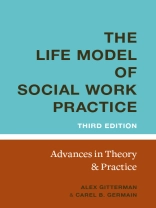Originally published in 1980, this seminal work was the first to introduce an ecological perspective into social work practice. The third edition expands and deepens this perspective, further developing the basic premise that, by being situated within the people:environment interface, the social work profession is distinct from other service professions. The book presents the ‘what’ (theories and concepts) and the ‘how’ (practice methods) to help people with their life stressors and, simultaneously, to influence communities, organizations, and policymakers to be more responsive to them.
In this edition, Gitterman and Germain examine major changes to our socioeconomic and political landscape. They restore a chapter on the history of social work practice, offering a view of the limited services for African Americans provided by settlements and charity organization societies. Building on the African American self-help and mutual aid traditions, this chapter traces the replication of a parallel social service system by African American leaders for their own communities. The chapter also addresses the impact of contemporary societal trends, including the global economy, immigration, cultural changes, and the technology revolution. In addition, it discusses current professional contexts of managed mental health care, evidence-based practice, and the professional uses of technology.
A new chapter explores issues and processes embedded in assessment, practice monitoring, and practice evaluation. The volume continues to feature innovative schema for assessment and intervention with respect to stressful life transitions and traumatic events, environmental pressures, and dysfunctional interpersonal processes. Practice illustrations offer reflections of today’s major social issues, such as AIDS, homelessness, and modern forms of violence.
Cuprins
Preface
Acknowledgments
Part 1: Overview
1. Social Work Practice and Its Historical Traditions
2. The Ecological Perspective
3. The Life Model of Social Work Practice: An Overview
4. Assessment, Practice Monitoring, and Practice Evaluation
Part 2: The Helping Process in Life-Modeled Practice
Initial Phase
5. Preparation: Settings, Modalities, Methods, and Skills
6. Beginnings: Settings, Modalities, Methods, and Skills
Ongoing Phase
7. Helping Individuals, Families, and Groups with Stressful Life Transitions and Traumatic Events
8. Helping Individuals, Families, and Groups with Environmental Stressors
9. Helping with Dysfunctional Family Processes
10. Helping with Dysfunctional Group Processes
11. Reducing Interpersonal Stress Between Worker and Client
Ending Phase
12. Endings: Settings, Modalities, Methods, and Skills
Part 3: Life-Modeled Practice at Community, Organization, and Political Levels
13. Influencing Community and Neighborhood Life
14. Influencing the Practitioner’s Organization
15. Influencing Legislation, Regulations, and Electoral Politics
Appendix A: Individual, Family, and Group Assessments
Appendix B: Practice Monitoring: Records of Service
Appendix C: Practice Monitoring: Critical Incidents
Notes
References
Index
Despre autor
Alex Gitterman is Zachs professor and director of the doctoral program at the University of Connecticut School of Social Work. He is the coeditor of Mutual Aid, Vulnerable and Resilient Populations, and the Life Cycle, Third Edition, and author of The Handbook of Social Work Practice with Vulnerable and Resilient Populations, Second Edition, which won the Robert Wood Johnson Award for excellence in end of life content. Currently, Professor Gitterman serves on the board of the Association for the Advancement of Social Work with Groups and as a commissioner on the Commission of Education and Curriculum Innovation and chair for the group work symposia of the Council on Social Work Education.The late Carel B. Germain was emerita professor of social work at the University of Connecticut. She is the author of Human Behavior in the Social Environment and editor of Social Work Practice: People and Environments.












